The healthcare landscape is undergoing a seismic shift, driven by both the impact of long drawn pandemic and evolving patient expectations. Today, patients demand convenient, accessible, and personalized care, and virtual care platforms are emerging as the answer. This surge in virtual care adoption isn’t just a temporary trend, it’s a transformative force shaping the future of healthcare delivery.
If you’re a healthcare leader considering launching your own virtual care platform, you’ve come to the right place. This comprehensive guide will equip you with the knowledge and tools you need to navigate this exciting new terrain. Whether you’re a established healthcare provider or a newcomer to the virtual care space, we’ll break down the key steps and empower you to build a successful and sustainable virtual care program.
Get ready to unlock the potential of virtual care and deliver exceptional healthcare experiences to your patients.
Let’s dive in!

Understanding the Virtual Care Landscape: A Spectrum of Possibilities
While virtual care and telehealth are often used interchangeably, they encompass distinct approaches to remote healthcare. Telehealth specifically involves real-time, interactive medical services conducted remotely via video conferencing or phone calls. In contrast, virtual care encompasses a wider array of healthcare solutions, including:
- Synchronous Video Consultations: This traditional telehealth setup facilitates real-time, face-to-face interactions between patients and healthcare providers.
- Asynchronous Messaging: Secure online platforms enable the exchange of text, images, and videos between patients and providers, ideal for follow-up inquiries or non-urgent matters.
- Remote Monitoring: Wearable devices or smartphone apps collect and transmit patient data (such as blood pressure or heart rate) remotely, facilitating proactive care and the management of chronic conditions.
But which model is right for you?
The answer lies in understanding the unique benefits and suitability of each:
- Synchronous Video Consultations: Well-suited for initial assessments, diagnoses requiring visual examination, and establishing patient-provider rapport. Particularly beneficial for primary care, mental health, and specialist consultations.
- Asynchronous Messaging: Ideal for routine follow-ups, medication refills, and addressing non-urgent concerns. Particularly effective for chronic disease management, post-operative care, and patient education.
- Remote Monitoring: Valuable for proactive management of chronic conditions like diabetes or heart failure, enabling early intervention and the mitigation of potential complications. Especially advantageous for high-risk patients and specialized fields like cardiology and pulmonology.
The Competitive Edge of Virtual Care: Embracing Opportunity in a Changing Landscape
The healthcare landscape is undergoing a transformation fueled by virtual care, and the numbers speak volumes.
A recent report by McKinsey & Company revealed a 175-fold increase in virtual care utilization since 2019, with a projected market value exceeding $262 billion by 2027.
This isn’t just a trend; it’s a paradigm shift driven by:
- Rising patient demand for convenience and accessibility: 76% of patients over 55 have used telemedicine, and 74% of millennials prefer it to in-person visits.
- Growing need to address healthcare disparities: Virtual care bridges the gap for underserved communities, offering remote access to specialists and reducing geographical barriers.
- Evolving healthcare delivery models: Virtual care platforms enable proactive care management, chronic disease monitoring, and remote consultations, enhancing overall efficiency.
But the benefits go beyond mere statistics. Virtual care can be a powerful tool for healthcare organizations to address critical challenges:
- Access: Virtual care platforms expand your reach, allowing you to serve patients in remote locations or with limited mobility, expanding your patient base and attracting new demographics.
- Cost: Studies show virtual care consultations can be 61% less expensive than in-person visits, reducing overall healthcare costs and making care more affordable for patients.
- Efficiency: Virtual consultations optimize resource allocation, reducing wait times and allowing clinicians to see more patients, leading to improved operational efficiency and increased revenue potential.
- Quality: Virtual care enables real-time data sharing and remote monitoring, facilitating proactive care and potentially improving clinical outcomes.
- Patient Satisfaction: Studies show higher patient satisfaction with virtual care, citing convenience, time savings, and reduced anxiety as key factors.
Building a Platform for Success: The DIBS Framework in Action
Now that you grasp the competitive edge of virtual care, let’s delve into the DIBS framework, a practical roadmap to building a successful platform. Remember, DIBS stands for Documentation, Integration, Best Practices, and Support.



1. Documentation: Laying the Foundation
Imagine a clear roadmap for your virtual care journey. Documentation does just that! It outlines the patient and staff workflows, detailing every step from scheduling appointments to conducting consultations and post-visit follow-up. This includes:
- Patient workflows: Pre-visit instructions, appointment reminders, virtual waiting room etiquette, and post-visit feedback mechanisms.
- Clinical protocols: Standardized virtual examination procedures, telehealth-specific communication guidelines, and data security protocols.
- Technology integrations: Seamless integration of scheduling platforms, video conferencing tools, electronic health records (EHR), and remote monitoring devices.
2. Integration: Seamless Flow, Seamless Experience
Imagine a patient effortlessly scheduling an appointment, accessing their records, and consulting with a clinician — all on a single platform. Integration makes this dream a reality. It ensures seamless connections between technology, data, and workflows for a smooth user experience. This includes:
- Choosing a platform that integrates with your existing EHR and IT infrastructure.
- Ensuring data security and privacy compliance through encryption and access controls.
- Implementing user-friendly interfaces and intuitive navigation for both patients and clinicians.
3. Best Practices: Adapting for Excellence
Imagine replicating the quality and engagement of in-person care in a virtual setting. Best practices make it possible. Adapt evidence-based practices to the virtual environment, ensuring clinical quality and patient satisfaction. This includes:
- Training clinicians on virtual examination techniques and telehealth communication skills.
- Using virtual tools (e.g., whiteboards, screen sharing) to enhance engagement and understanding.
- Implementing patient education materials and resources within the platform.
4. Support: Building Confidence and Trust
Imagine patients and clinicians feeling empowered and supported in the virtual environment. Support ensures everyone feels confident and ready to navigate this new terrain. This includes:
- Providing comprehensive training resources for patients on using the platform and technology.
- Offering dedicated technical support for both patients and clinicians.
- Establishing clear communication channels for questions and concerns.
How we can be your guide to building a thriving virtual care platform?
Navigating the world of virtual care platforms can be complex, but with AnAr Solutions, you have a trusted partner by your side. We understand the challenges and opportunities that healthcare organizations face, and we’re dedicated to helping you build a successful platform that meets your unique needs and goals.
AnAr’s Technology Framework: Built on the DIBS Model for Success
Our foundation lies in our robust technology framework, specifically designed to align with the key aspects of the DIBS model: Documentation, Integration, Best Practices, and Support. This ensures a seamless, efficient, and effective virtual care platform that:
- Streamlines workflows and reduces errors through clear documentation for patients, staff, and clinicians.
- Connects seamlessly with existing systems like EHRs and scheduling tools, eliminating data silos and improving operational efficiency.
- Delivers high-quality care by adhering to industry best practices and providing the necessary tools and training for clinicians.
- Empowers both patients and providers with comprehensive support, resources, and technical assistance.
1. Quick Development and Deployment: Closing the Gap Between Need and Action
We recognize the urgency to implement virtual care solutions. That’s why our team of experts leverages its extensive healthcare technology knowledge to help you swiftly develop and maintain your platform. We bridge the gap between the need for virtual services and your operational readiness, allowing you to start reaping the benefits sooner.
2. Customization and Integration: Tailored Solutions for Seamless Transitions
We know that one-size-fits-all solutions rarely succeed. AnAr Solutions takes a client-centric approach, tailoring our platform to your specific needs and ensuring smooth integration with your existing systems. This minimizes disruption to your workflow and enhances user adoption.
3. Support and Best Practices: Your Journey Doesn’t End at Launch
Our commitment to your success extends beyond the initial implementation. We provide comprehensive support, including:
- Detailed documentation for all stakeholders.
- Expert guidance on integration strategies.
- Dedicated technical support for both patients and clinicians.
- Ongoing training and resources to ensure best practices are followed.
With AnAr Solutions, you have access to a team of experienced professionals who understand the virtual care landscape and are dedicated to your success.
Conclusion —
The future of healthcare is undeniably connected to the transformative power of virtual care. With its potential to improve access, enhance patient experience, and optimize clinical outcomes, it’s no wonder healthcare organizations are increasingly embracing this paradigm shift.
But building a successful virtual care platform requires more than just technology. It demands a deep understanding of the healthcare landscape, its challenges, and the unique needs of each organization. That’s where AnAr Solutions comes in.
We have extensive experience in developing and implementing virtual care platforms for healthcare organizations of all sizes and specialties. Our robust technology framework, client-centric approach, and unwavering commitment to support empower you to overcome challenges and achieve your virtual care goals.







